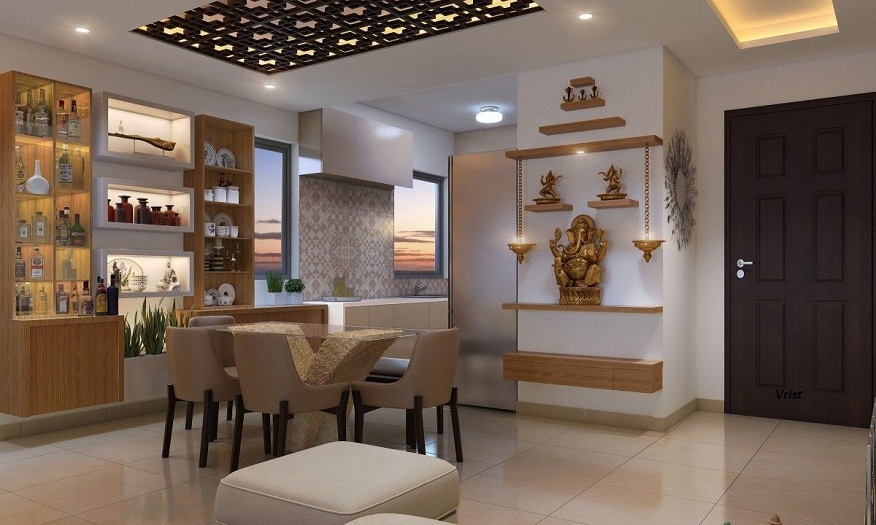In the midst of our bustling, modern lives, a personal sanctuary where we can connect with our spiritual selves is more important than ever. This is where the concept of pooja room design for contemporary homes comes into play. A home mandir, or prayer area, that blends tradition with modern aesthetics can become a calming, serene space for daily reflection and meditation.
This guide will explore how you can incorporate a mandir into your contemporary home in a way that respects traditional principles while also embracing the sleek simplicity of modern design.
1. Jaali Home Temple Design For Modern Interiors
This pooja room design masterfully incorporates the traditional art of jaali – a form of ornamental perforated stone or latticed screen – into a contemporary setting. The intricate patterns of the jaali create a visually stunning backdrop for your sacred space, offering an elegant contrast to the sleek, uncluttered aesthetics of modern homes. This fusion of old and new makes the Jaali Home Temple not just a spiritual haven, but also an exquisite piece of art that adds character to your interiors.
2. A Grand Marble Home Temple Design That Is Timeless
Carved from the timeless beauty of marble, this grand home marble pooja room design is the epitome of luxury and durability. The natural veins and swirls in the marble lend a unique touch to each piece, ensuring your home temple is as individual as you. Perfect for those who appreciate the finer things in interior design. This marble pooja room design exudes elegance and sophistication, creating a serene and inviting space for your spiritual practices.
3. Pooja Room with Customized Door Design
This design concept emphasizes personalization, allowing you to customize your pooja room door with intricate carvings or contemporary patterns. It creates an element of intrigue and anticipation, as the beautifully designed door opens to reveal a tranquil, dedicated space for worship and meditation. It’s a lovely way to add a personal touch to your spiritual corner, making it truly reflective of your beliefs and aesthetics.
4. A Wooden Home Temple Design For A Natural Look
Embracing the organic beauty of wood, this home temple design exudes warmth and tranquility. The rich grain patterns and textures of the wood add depth to your interiors, creating an inviting and peaceful atmosphere. Whether it’s crafted from dark mahogany or light pine, a wooden home temple adds a touch of nature to your home, fostering a serene environment for reflection and prayer.
5. A Marble Cum Wooden Home Temple Design
This design beautifully marries the elegance of marble with the earthy charm of wood. The marble provides a touch of opulence, while the wood adds warmth and a natural feel. Striking a perfect balance between luxury and simplicity, this versatile design can seamlessly blend with various interior styles, from rustic to contemporary, making it a popular choice for many homeowners.
6. A Tall Home Temple Unit With a Glass Door & Jaali Sides
This design is a contemporary reinterpretation of traditional home temples. The towering structure commands attention, while the glass door and jaali sides add a touch of delicacy and finesse. It’s an excellent choice for those who want to make a statement without sacrificing the intimate, spiritual essence of a home temple.
7. A Simple Home Mandir Design For Minimalist Interiors
Perfect for minimalist homes, this design focuses on simplicity and functionality. It provides a quiet, unobtrusive space for meditation and prayer, without compromising on style or personal expression. The clean lines and understated elegance of this design create a calming environment, allowing you to focus on your spiritual journey rather than the decor.
Incorporating a pooja room design into your contemporary home doesn’t mean you have to compromise on style or lose the essence of your interior design. In fact, there is a home temple design to suit every aesthetic and spiritual need. You just have to choose a design that beautifully blends the sacred and the aesthetic.

